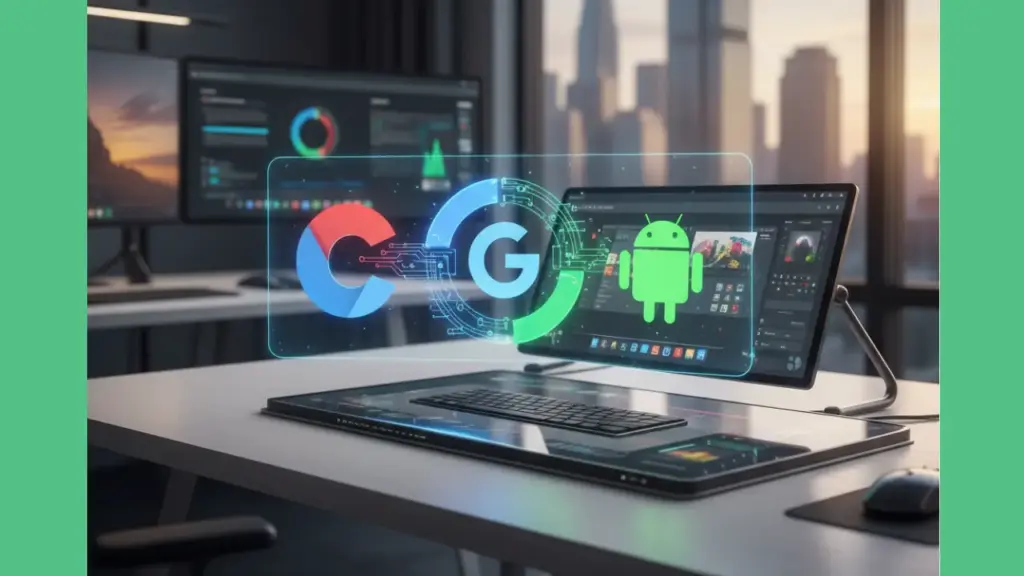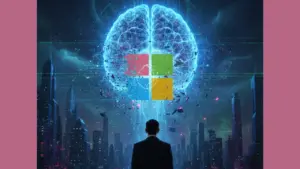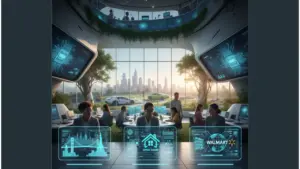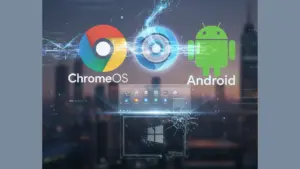1. Introduction: The Future of Computing is Here
For decades, the PC market has been ruled by two giants — Microsoft and Apple. Google, meanwhile, built its empire through Android and ChromeOS. But now, the tech giant is preparing for its most ambitious move yet: merging ChromeOS and Android into one unified platform.
This shift isn’t just about software. It’s about reimagining the PC experience through AI integration, ARM-based performance, and seamless connectivity across devices. Google’s vision is bold — to make Android the heart of every computing category, from smartphones to desktop PCs.
If successful, this merger could change how people work, develop, and interact with technology forever.
2. Google’s Unified Vision: One Platform for All Devices
Google’s strategy is to build a common foundation where Android and ChromeOS converge. Instead of maintaining two parallel ecosystems, Google wants one system that scales effortlessly across devices — phones, tablets, Chromebooks, and PCs.
This unified operating system would let developers build once and deploy everywhere. Imagine an app that runs flawlessly on your phone, then extends naturally to your desktop — same account, same experience, just optimized for each screen.
It’s a vision Microsoft once chased but never achieved. Despite years of effort with Windows Phone, Surface Duo, and hybrid devices, Microsoft couldn’t bridge the gap between mobile and desktop. Google, with its dominance in mobile and its powerful AI infrastructure, might finally pull it off.
And this time, it’s not just about operating systems — it’s about creating a smart, adaptive, AI-powered ecosystem.
3. The Power Behind It: ARM-Based Processors and AI Integration
At the core of this transformation are ARM-based processors — chips known for efficiency and performance. Google, in partnership with Qualcomm, plans to use ARM architecture to power the next generation of AI-enabled PCs.
ARM chips are lightweight, energy-efficient, and perfect for mobile-like experiences on larger devices. They’re already powering smartphones and Chromebooks, but now they’re stepping into the desktop space.
Paired with Google’s AI stack, these processors can run advanced machine learning models locally. That means faster performance, longer battery life, and real-time intelligence — without relying solely on the cloud.
From predictive text to smart file organization and contextual search, Google’s AI layer will bring desktop computing into a new era. And for businesses, this integration could lead to smarter workflows, reduced operational costs, and greater flexibility.
4. What It Means for Developers
For developers, the unification of ChromeOS and Android means opportunity — and challenge.
The opportunity lies in a single ecosystem that reduces development time. A developer can write code once, and Google’s system can automatically optimize it for phones, tablets, and desktops. This could significantly lower app fragmentation, one of Android’s long-standing issues.
However, there are challenges, too. Developers must rethink UI and performance optimization for larger screens and more powerful hardware. The desktop experience demands more from applications — keyboard shortcuts, multitasking, and higher-resolution visuals.
But Google is likely to support this transition with updated SDKs, better emulators, and AI-assisted developer tools. The company’s Gemini AI could help developers write, debug, and optimize apps faster.
In this new environment, innovation won’t just depend on coding skills — it will depend on how well developers integrate AI capabilities into their apps.
5. The Potential Impact on the PC Market
If Google executes this vision successfully, the PC landscape could shift dramatically.
Windows has long dominated personal and enterprise computing. But a unified Android-ChromeOS ecosystem could challenge that dominance by offering a lighter, faster, and AI-first alternative.
Manufacturers could start building Android-powered laptops that boot in seconds, sync seamlessly with mobile apps, and deliver longer battery life than traditional PCs.
For consumers, it means simplicity — fewer updates, cloud-synced data, and access to millions of Android apps directly from the desktop. For enterprises, it means scalability, reduced licensing costs, and easier device management through Google Workspace integration.
This change could also force competitors like Microsoft and Apple to rethink their operating systems and adopt deeper AI integrations.
6. The User Experience Revolution
The user experience is where Google plans to shine. The new platform promises to unify everything users already love about Android — simplicity, personalization, and flexibility — with the productivity and multitasking power of ChromeOS.
Users could move between devices effortlessly. You might start writing an email on your Android phone and finish it on your laptop — instantly synced and AI-optimized.
Google Assistant, Gemini AI, and the Play Store will play central roles. Imagine using your voice to control desktop applications, summarize documents, or translate conversations in real time — all processed locally through ARM-powered AI.
This level of integration could redefine what “user-friendly” truly means. It’s not just about speed or performance anymore. It’s about intelligence, personalization, and adaptability.
7. Challenges Ahead
No major transition comes without obstacles.
One concern is compatibility. Google will need to ensure that legacy ChromeOS and Android apps work smoothly on the unified platform. There’s also the issue of hardware optimization — different manufacturers will have different specifications, making consistency a challenge.
User adoption will take time, especially among enterprise clients deeply embedded in Windows ecosystems. Security and privacy will also be under scrutiny. With AI integration at the core, Google must handle user data responsibly and transparently.
Finally, Google faces strong competition from Microsoft’s Copilot PCs and Apple’s M-series Macs, both of which emphasize AI performance and seamless device integration.
The success of this project depends on how effectively Google can deliver value, trust, and reliability — not just innovation.
8. The Bigger Picture: Fractional CTO Perspective
From a Fractional CTO perspective, this merger represents a major inflection point in enterprise technology strategy.
Startups and mid-sized companies often rely on agile, cost-effective solutions to scale fast. A unified Android-ChromeOS ecosystem offers precisely that — a platform that’s AI-native, cloud-ready, and easy to maintain.
By adopting this system early, organizations can leverage AI tools that enhance collaboration, automate tasks, and optimize infrastructure costs. Teams can develop and deploy applications across devices without maintaining separate codebases or environments.
Fractional CTOs see another key advantage: flexibility. Businesses can experiment with emerging technologies, integrate AI models into their workflows, and pivot quickly — all within Google’s scalable ecosystem.
In a world moving toward hybrid work and decentralized teams, this adaptability could be the ultimate competitive edge.
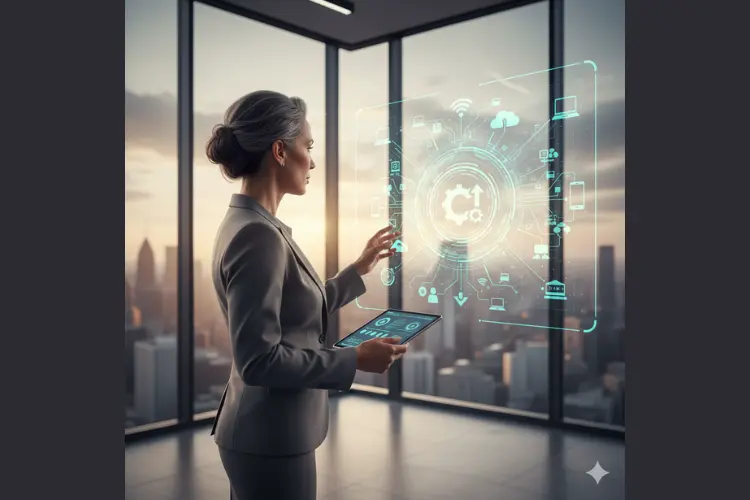
9. Conclusion: The Beginning of a New Computing Era
Google’s decision to merge ChromeOS and Android signals a bold shift toward an AI-first computing future. By blending the efficiency of ARM processors, the intelligence of Gemini AI, and the flexibility of Android, Google is setting the stage for a new generation of PCs.
This vision could reshape the way developers build apps, how users interact with technology, and how businesses operate in an increasingly digital world.
Yes, challenges exist — but innovation thrives on disruption. As history has shown, the companies that adapt early to new platforms are the ones that lead tomorrow’s market.
For entrepreneurs, developers, and digital leaders — especially those exploring opportunities with Fractional CTO expertise — this moment could define the next decade of computing strategy.
At StartupHakk, we believe this convergence marks more than just another tech update. It’s the dawn of intelligent, adaptive, and unified computing — where every device becomes smarter, every process becomes faster, and every user becomes more empowered.

